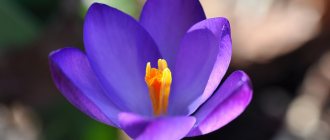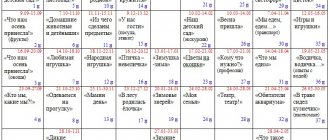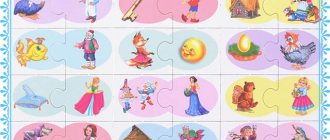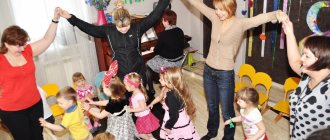"The world of sensory". Club work in the first junior group. Educator: Kushtein I.N.
Transcript
1 Municipal budgetary preschool educational institution "Kindergarten "Achairsky" Club work in the first junior group "World of Sensorics". Educator: Kushtein I.N. 2016
2 Goal To form in children the perception of individual properties of objects and phenomena: shape, color, size, space, time, movements, special properties. To teach children to perceive such complex phenomena of the surrounding world as illustrations, literary works, social phenomena, movements, nature, music. Learning objectives Development of visual sensations: learn to distinguish the color, shape, size of an object. Development of tactile sensitivity: learn to distinguish the quality of objects by touch and name them (soft, fluffy, hard, etc.); development of hand strength, fine motor skills, coordination of movements. Development of auditory sensitivity, the ability to listen and distinguish sounds in the environment, development of speech hearing. Draw children's attention to the difference in size of objects; develop an understanding of the words “big” and “small”. Strengthen children's ability to group and correlate by color, shape and size. Introduce children to the five geometric shapes and their names. Give ideas about the alternation of objects according to form. Expected result Children distinguish and name some colors of the spectrum: red, green, blue, yellow. Some geometric shapes and bodies are distinguished and named (ball, cube, circle, square). They use sensory standards (a lemon is yellow like the sun, a cucumber is green like grass). They begin to distinguish the quality of objects by touch and name them. They are able to listen and distinguish sounds in the environment. Methods: Game method (didactic games). Visual method (examination of teaching aids and objects). Practical demonstration of ways to operate with objects, experiment. Forms of organization of activities: group; subgroup; individual. Expected result Children distinguish and name some colors of the spectrum: red, green, blue, yellow. Some geometric shapes and bodies are distinguished and named (ball, cube, circle, square). They use sensory standards (a lemon is yellow like the sun, a cucumber is green like grass). They begin to distinguish the quality of objects by touch and name them. They are able to listen and distinguish sounds in the environment.
3 Month PERSPECTIVE PLANNING OF CLASSES ON THE DEVELOPMENT OF SENSORY STANDARDS Lesson Goal Equipment, materials SEPTEMBER Diagnostics To identify children’s knowledge in the field of sensory standards of color and shape through didactic material at the beginning of the year. Toys and games from the sensory corner. 1. “Name the geometric figure.” Teach children to recognize and correctly name plane geometric shapes. Circle, square, triangle, oval, rectangle. 2. “Spooning.” Teach your child to pour grains with a spoon, remember the sequence of actions, and develop independence. Peas, spoons, deep containers. OCTOBER NOVEMBER 3. “Jump along the track.” 4. "Sorting". 1. “Find an object of the same shape.” Consolidating knowledge of colors: red, yellow, blue, green. To develop stereognostic perception in children in connection with visual representations. Teach children to recognize and correctly name planar geometric shapes. A cardboard track 40 cm long and 10 cm wide, as well as strips of green, red, blue and yellow colors 4 cm wide, toys. Balls of different colors. "Geometric Lotto"
4 2. “Treat the little and big hare with carrots.” 3. “Noisy boxes.” 4. "Lights at night." 1. “Magic tray”. 2. “Balls” Consolidating the ability to group and correlate homogeneous objects by size. Develop auditory perception, learn to make pairs of identical noises. To promote the further formation in children of an attitude towards color as an important property of objects, to lead them to independently choose a given color. Teach the technique of applying a smear using the dipping method. Teach children to perform tasks correctly and develop fine motor skills. Teach children to select objects of the same color; name the colors. Toy bunnies and carrots of different sizes. Paired noisy boxes. Black paper, yellow gouache, brushes, jars of water. Tray with a plain colored bottom, cereal. Balls of primary colors. DECEMBER 3. “Choose according to the shape.” 4. Games with clothespins: laying out objects according to a pattern (sun, Christmas tree, hedgehog) Consolidating knowledge of geometric shapes: circle, square, triangle, oval. Develop fine motor skills in children. Block inserts for each child. Clothespins. Silhouettes: sun, Christmas tree, hedgehog, cloud, berry. JANUARY 1. “Who will collect the toys sooner?” Teach children to group objects that differ in shape, size, purpose, but have the same color. "Toys".
5 FEBRUARY MARCH 2. “Counting sticks.” Teach children to lay out various figures using counting sticks. 3. "Cinderella". Teach children to sort objects (beans) by color, develop fine motor skills. 1. "Balloons." Consolidating knowledge of colors: red, yellow, blue, green. 2. Finger games with walnuts: rotation between palms, rolling on the table in different directions. Develop fine motor skills in children. 3. Water coloring. Formation of ideas about shades of colors (light, dark). 4. “Let’s help the bunny sort out the toys.” Consolidating knowledge of geometric shapes: circle, square, triangle, oval. 1. "Fabrics". Develop children's sense of touch, teach them to make pairs of fabrics that feel the same to the touch. 2. “Building a tower.” Learning to correlate the sizes of four objects. Counting sticks. Beans, plates. "Balloons". Walnuts. Water in transparent containers, paints in light and dark shades. Toys: hares, sensory cube with geometric and shapes: circle, square, triangle, oval. Pairs of fabrics that have the same feel. Building material: cubes.
6 3. “What’s in the bag?” 4. “Pick up a feather for the cockerel” Consolidate children’s knowledge about shape, practice the correct correlation of several objects with the same geometric patterns. Learn to distinguish and name primary colors; repeat simple and relatively complex phrases. "Magic bag" “Pick up a feather for the cockerel.” APRIL 1. “Let’s make beads for the dolls.” Strengthen the ability to group objects by color, learn to string beads on a thread. 2. “Hide the mouse.” To reinforce children's ideas about six colors. 3. Games with counting sticks: laying out objects according to a pattern. Develop fine motor skills in children. Laces or ropes, multi-colored beads according to the number of children. “Hide the mouse.” Counting sticks of primary colors, samples of objects. MAY 4. “Tower of cubes.” Teach children to compare several objects by size (smaller, even smaller) and arrange them in decreasing order of size. Diagnostics Identify children’s knowledge in the field of sensory standards of color and shape through didactic material at the end of the year. Wooden cubes. Toys and games from the sensory corner.
ADDITIONAL EDUCATION PROGRAM FOR EARLY CHILDREN
Transcript
1 ADDITIONAL EDUCATION PROGRAM FOR EARLY CHILDREN
2 Promoting the harmonious development of a young child through the creation of a specially organized artistic and visual educational development environment PROGRAM OBJECTIVE
3 OBJECTIVES OF THE PROGRAM FOR EARLY CHILDREN
4 ART OFFICE EQUIPMENT CONDITIONS OF IMPLEMENTATION * OPTIONAL
5 SKILLS IN WORKING WITH MATERIALS OF DIFFERENT TEXTURES, PROPERTIES AND TOOLS CREATING LINES, SHAPE, COLOR IMAGE OF OBJECTS WITH A SMALL AMOUNT OF DETAILS SKILL IN TRAKING THE CONTOUR OF SIMPLE GEOMETRIC FORMS IMPLEMENTATION TECHNOLOGY
6 GROUP LESSON WELCOME THE HERO ON THE TOPIC DRAWING ON PAPER INDIVIDUAL LESSON WORK HAND IN HAND SAND/PAPER GAME ON REQUEST ORGANIZATION OF THE CLASS
7 IMPLEMENTATION: “ON A VISIT TO THE FOX BRUSH” THE HERO INTRODUCES THE MAGICAL WORLD OF CREATIVITY AND WAYS OF DISPLAYING REAL OBJECTS: COLOR, SPOT, LINE, SHAPE, RHYTHM
8 COLOR
9 COLOR ON THE SAND TABLE WE GET TO KNOW THE MAGICAL WORLD FOR EXAMPLE: THE TABLE IS ON AND OFF ONLY WITH THE HELP OF MAGIC WORDS ONE, TWO, THREE OUR TABLE BURN ONE, TWO, THREE DO NOT BURN ANYMORE ADVICE CHOOSE THE COLOR OF THE TABLE APPROPRIATELY TO THE OBJECT DEPICTED. GRASS - GREEN. SUN-YELLOW
10 COLOR WITH PAINTS WE STUDY THE PRIMARY COLORS AND METHODS OF APPLYING DIFFERENT PAINT ON PAPER: WITH FINGERS, A BRUSH, A STAMP ADVICE BEFORE Drawing an object, introduce your child to it through play
11 COLOR WE USE CONTRASTING COLORS TO CREATE COMPOSITIONS ADVICE OFFER YOUR CHILD PAPER OF DIFFERENT COLOR AND SHAPE
12 SPOT
13 A STAIN ON THE SAND TABLE WE GET TO KNOW THE PRINTS OF OUR HANDS OR LEAVE TRACES WITH TOYS AND VARIOUS OBJECTS ADVICE CHOOSE OBJECTS THAT DO NOT SCRATCH THE TABLE SURFACE THAT CAN LEAVE A CLEAR IMPRINT
14 STAINING WITH PAINTS USING COLOR SPOTS LET’S GET TO KNOW WITH COLOR AND LEARN THE PROPERTIES OF PAINTS ADVICE SURPRISE YOUR CHILD WITH NEW TECHNIQUES: HAVEN’T HAD APPEARED (WAX CRAYONS AND WATERCOLORS)
15 LINES
16 LINES ON A SAND TABLE LEARNING WAYS TO CREATE STRAIGHT AND CURVED LINES ADVICE: IN ADDITION TO YOUR HANDS AND FINGERS, USE COMBES, BRUSHES, STICKS
17 LINES ON A SAND TABLE LEARNING WAYS TO CREATE WAVY LINES ADVICE SPEAK IN A SOFT VOICE STRETCHING THE WORDS, THIS WILL HELP THE CHILD TO FEEL THE SMOOTHNESS OF THE LINE
18 FORM
19 SHAPES ON A SAND TABLE LEARNING WAYS TO CREATE DIFFERENT SHAPES CLOSING THE LINES ADVICE YOU CAN DRAW WITH ONE OR TWO HANDS AT ONCE
20 SHAPES ON A SAND TABLE WE GET TO KNOW DIFFERENT GEOMETRIC FIGURES, OUTLINE THE ADVICE DRAFT THE CHILD'S ATTENTION TO SHARP CORNERS. USE A WARNING INTONATION “AY, SHARP!”
21 SHAPES ON A SAND TABLE WE CREATE A WHOLE FROM TWO-THREE PARTS, USING DIFFERENT FIGURES ADVICE TAKE GEOMETRIC FIGURES FROM TRANSPARENT PLASTIC. WHEN THE LIGHT IS TURNED ON IN A COLOR MATCHING IT, IT WILL BE INDISCOUS. THE CHILD WILL BE SURPRISED WHEN THE FIGURE APPEARS IN A DIFFERENT COLOR.
22 SHAPES ON PAPER WE USE TACTILE MATERIALS: PLASTICINE, SALT DOUGH ADVICE FOR DECORATING A CRAFT USE SMALL PARTS BY PRESSING THEM INTO THE SURFACE OF THE FIGURE
23 RHYTHM
24 RHYTHM ON A SAND TABLE DRAW SHORT LINES SPEAKING RI ADVICE INVITE THE CHILD TO CHOOSE AN OBJECT FOR DRAWING A FINGER, A BRUSH, A STICK
25 RHYTHM ON GRAPHITE PAPER STRENGTHENING THE SKILL ON A VERTICAL SURFACE USING CRAYONS ADVICE OFFER YOUR CHILD TO CHANGE THE COLOR OF THE CRAYON TO REPEAT THE COLORS AND KEEP ATTENTION FOR A LONGER TIME
26 DEVELOPMENT OF TWO HEMISPHERES
27 DRAWING WITH TWO HANDS DRAW WITH ALL FINGERS OR WITH ONE TWO HANDS AT THE SAME TIME STRAIGHT AND WAVY LINES ADVICE USE THIS METHOD WHEN YOU NEED TO Draw MANY LINES
28 TOGETHER WITH PARENTS MOTHER'S DAY
29 PORTRAIT OF A MOTHER WE DRAW WITH FINGER PAINTS AND USE ALL PRIMARY COLORS ADVICE USE FINGER PAINTS WITH INCREASES, UNHOMOGENEOUS TO THE TOUCH. SAND CAN BE ADDED TO HOMOGENEOUS PAINTS
30 PORTRAIT OF A MOTHER WE ESTABLISH A CONNECTION BETWEEN AN OBJECT IN THE SURROUNDING WORLD AND ITS DISPLAY (EYE COLOR, HAIR LENGTH) ADVICE THE PRESENCE OF A MOTHER HELPS TO FORM A VIBRANT POSITIVE EMOTIONAL RESPONSE OF THE CHILD TO HIS WORK
31 CREATION OF SIMPLE STORY COMPOSITIONS
32 DRAWING WITH APPLIQUE ELEMENTS LEARNING TO PERCEIVE A SHEET OF PAPER AS A SPACE FOR A COMPOSITION ADVICE CREATE EXPRESSIVE IMAGES: FLUFFY CLOUDS, CHICKENS IN A MEADOW, CURLY SHEEP)
33 MONITORING RESULTS FOR EARLY CHILDREN MONITORING AT THE BEGINNING AND END OF THE TRAINING PERIOD SKILL OF CREATING LINES OF DIFFERENT FORMS CRITERIA: IN THE INITIAL STAGE / WITH SUPPORT / INDEPENDENTLY SKILL OF TRAKING ALONG THE CONTOUR IMAGE OF OBJECTS WITH WITH A SMALL NUMBER OF PARTS NAVK WORKS WITH DIFFERENT TOOLS
34 Regional experimental site SPEAKERS: OLGA ANDREEVNA KERNER, methodologist Natalya Aleksandrovna Voronina, additional education teacher IMPROVING EARLY DEVELOPMENT OPPORTUNITIES IN PRESCHOOL EDUCATION



